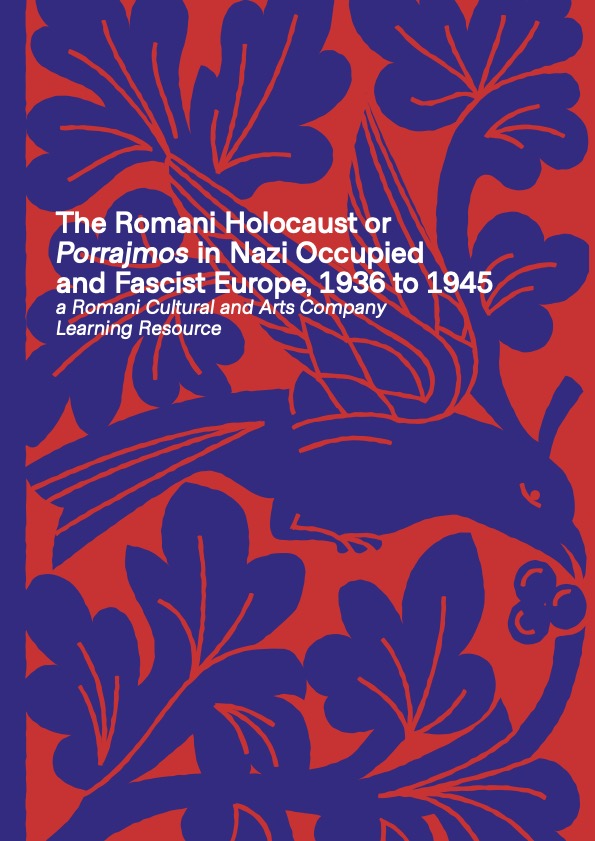A learning resource pack for secondary schools in Wales
Today, the Romani Cultural & Arts Company launches a new resource for secondary schools in Wales, about the Romani Holocaust or Porrajmos. The learning resource is the result of over a year’s work by a dedicated team of academics, artists, designers, and project managers, all of whom are from the Romani and Traveller communities. The Romani Holocaust, or Porrajmos as it is described in the Romani language (after it was coined as a term in the late 1990’s, by Dr Ian Hancock, Professor of Romani Linguistics at the University of Texas at Austin) was an episode in the genocidal relationship of non-Romani, and Romani people – the Sinti, Roma, Woonwagenbewoners, Manush, Gens de Voyage, Yenische, Ashkalé, Egyptian, Ijito, Getano, Quinqui, Mercheros, and other Romani groups in Nazi Germany and fascist occupied Europe, 1936 to 1945.
The learning resource is intended as a guide for educators, teaching assistants, and older pupils in schools in Wales, though it is also hoped that Gypsy, Roma, Traveller voluntary and Third Sector organisations will find it useful in work with young Romani and Traveller people in community environments, especially those that work with youngsters not in education, employment, or training (NEET). The resource is broad in its coverage of the themes surrounding the topic, including a shorter history of Gypsy, Roma, Traveller communities, the development of racialised ‘thinking’ about Gypsies, and the terrible illogic of eugenics that led to the Holocaust of Sinti, Roma, Manush, Gitano, and other Romani communities under Nazi control or that of their allies in Europe (such as fascist Spain). A special section about the least well-known and understood experiences in the countries of south east Europe, such as Bulgaria, Rumania, and Yugoslavia, is also included in the resource, as a topic that has been largely ignored, even if the knowledge about the Romani Holocaust itself has become better known over the last thirty years than was once the case.
The Department for Levelling Up, Housing, and Communities provided funding for this project, which was managed by Isaac Blake at the Romani Cultural & Arts Company and coordinated by Dr Adrian Marsh of the international Romani Studies Network (iRSN), himself of Welsh Gypsy and Traveller origins. Dr Marsh praised his fellow researchers, artists, designers, and editor for their invaluable work on this resource, saying,
“The Romani Holocaust or Porrajmos learning resource for secondary schools in Wales is an important step in bringing this much misunderstood, and little-known topic into the mainstream education environment. The key to this particular initiative is that those who worked on this, Dr Aleks Marinov, Imogen Bright Moon, Sion Dyfedd, Isaac Blake, and myself all bear a responsibility to those families of the Roma, Sinti and other Romani communities who perished, and those individuals who survived, through our own ‘witnessing’. It is our responsibility not just to bring the stories and sequence of events to a wider community, to ensure that more than just those working in this field in dusty archives and photographic libraries know what happened, but also to honour their memories and the spirits of those who died at the hands of racist, extremist, and fascist perpetrators. It’s also our honour to work in partnership with non-Romani researchers and academics, such as Dr Thomas Acton, Professor Emeritus in Romani Studies, as our eloquent editor, mentor, and life-long advocate for Romani and Traveller rights, to bring this essential learning resource to fruition.”
The ultimate aim of the resource is to raise awareness of the topic, to support those educators in bringing the topic into the mainstream learning environment, and to provide them with some tools, including lesson plans, to deliver the data from the best knowledge available. Romani Cultural & Arts Company hopes to be able to further support educators with training for them in the future, on how ot best use the resource, if funding becomes available. In the meantime, every school in Wales has a digital copy of the learning resource and additional copies can be downloaded from the Romani Cultural & Arts Company website, https://romaniarts.co.uk

